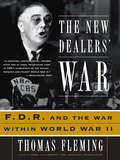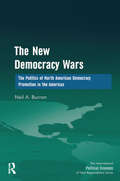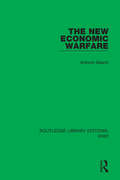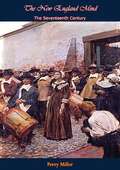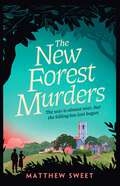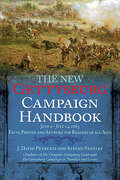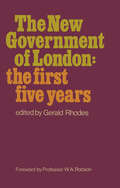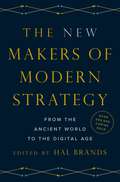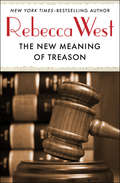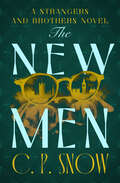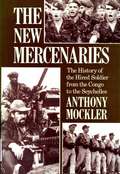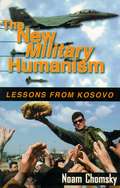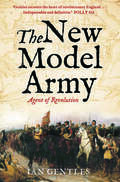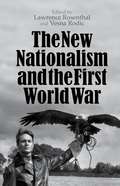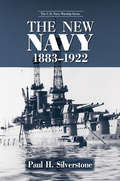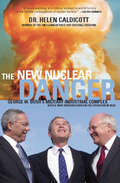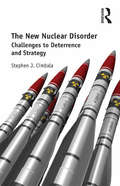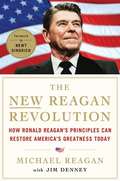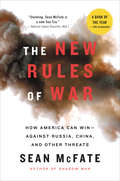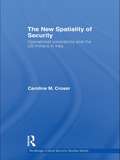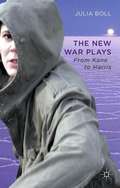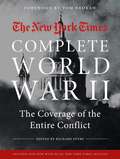- Table View
- List View
The New Dealers' War: Franklin D. Roosevelt and the War Within World War II
by Thomas FlemingAcclaimed historian Thomas Fleming brings to life a flawed and troubled FDR struggling to manage World War II. Starting with the leak to the press of Roosevelt's famous Rainbow Plan, then spiraling back to FDR's inept prewar diplomacy with Japan and his various attempts to lure Japan into an attack on the U. S. Fleet in the Pacific, Fleming takes the reader on a journey through the incredibly fractious struggles and debates that went on in Washington, the nation, and the world as the New Dealers strove to impose their will on the conduct of the War. In bold contrast to the familiar, idealized FDR of other biographies, Fleming's Roosevelt is a man in remorseless decline, battered by ideological forces and primitive hatreds that he could not handle and frequently failed to understand, some of them leading to unimaginable catastrophe. Among FDR's most dismaying policies, Fleming argues, is his insistence on "unconditional surrender" for Germany (a policy that perhaps prolonged the war by as much as two years, leaving millions more dead) and his often-uncritical embrace of and acquiescence to Stalin and the Soviets as an ally. The New Dealers' War is one of those rare books that force readers to rethink what they think they know about a pivotal event in the American past.
The New Democracy Wars: The Politics of North American Democracy Promotion in the Americas (The International Political Economy of New Regionalisms Series)
by Neil A. BurronBurron provides a critical analysis of Canadian and US democracy promotion in the Americas. He concentrates on Haiti, Peru, and Bolivia in particular but situates them within a larger analysis of Canadian and US foreign policy - bilateral and regional - in the areas of trade, investment, diplomacy, security and, for the United States, the war on drugs. His main argument is that democracy promotion is typically formulated to advance commercial, geopolitical and security objectives that conflict with a genuine commitment to democratic development. Given this broad scope, the book is well positioned to contribute to a number of debates in comparative Latin American politics and international political economy (IPE) with a focus on North-South relations in the hemisphere.
The New Economic Warfare (Routledge Library Editions: WW2 #21)
by Antonín BaschThis book, first published in 1942, examines the economic necessities, defensive and offensive, basic and strategic, involved in waging war. Written with total global war raging, it analyses the unprecedented demands placed on the economic system of a nation, and looks at the great shifts of productive effort and limits on consumption that were needed.
The New England Mind: The Seventeenth Century
by Perry MillerIn The New England Mind: The Seventeenth Century, as well as successor The New England Mind: From Colony to Province, Perry Miller asserts a single intellectual history for America that could be traced to the Puritan belief system.“A fascinating and indispensable book.”―Saturday Review“This classic work towers over the great mass of subsequent scholarship, and remains after forty years our single best work on American Puritanism… For many years to come every serious student of American Puritanism will still have to begin by reading The New England Mind.”―James Hoopes“A magnificent book, the most illuminating and convincing interpretation of Puritanism that I know and a model example of intellectual historiography. Miller seems to possess a rare combination of gifts and acquired intellectual virtues―disciplined faithfulness to sources, philosophical insight and outlook, creative imagination.”―H. Richard Niebuhr“The New England Mind is an authoritative description of Puritanism, the most subtle and most fully coherent intellectual system which has ever functioned as the official code of an American regional society… The book is the best single illustration of what is meant by ‘the history of ideas’ as a method of dealing with American materials.”―Henry Nash Smith―Print ed.
The New Face of War: How War Will be Fought in the 21th Century
by Bruce BerkowitzEmphasizes the importance of technology, especially of increased importance of communication.
The New Forest Murders: A page-turning wartime murder mystery, perfect for fans of Agatha Christie's Partners in Crime
by Matthew SweetA compelling mystery for fans of Foyle's War. Summer 1944. The tide of war is turning. The Allies are at the gates of Paris. But the Nazis have one last chance of victory – and its success depends on a traitor in the quiet English village of Larkwhistle in the New Forest. When Jill Metcalfe receives the news of her brother Henry&’s death from his friend, US Air Force officer Jack Strafford, she learns of more than just his loss – she is recruited to continue his mission. Jack has come to the village in the hope that Henry&’s cryptic last words will reveal the identity of the traitor he is hunting. With Jill at his side, they begin to investigate. But someone doesn&’t want them looking into what happened to Henry. And when a body is discovered, it seems like there might be more to this little village – and its inhabitants – than first meets the eye. Will they discover the traitor in their midst, or will the war claim more victims?
The New Gettysburg Campaign Handbook: Facts, Photos, and Artwork for Readers of All Ages, June 9–July 14, 1863
by Steven Stanley J. David PetruzziThe New Gettysburg Campaign Handbook is an informative full-color guide for American Civil War and Gettysburg enthusiasts of all ages. Authors J. David Petruzzi and Steven Stanley use clear and concise writing broken down into short and easy to understand chapters complete with original maps, modern and historic photographs, tables, charts, and artwork to narrate the history of the Gettysburg Campaign from the opening battle at Brandy Station in Virginia on June 9, 1863, to the escape of Gen. Robert E. Lee’s Confederate Army of Northern Virginia across the Potomac River on July 14, 1863. Chapters include quotes of interest from participants, tables and charts of the ages and seniority ranking of the generals of both sides; weather observations during the battle; a stunning photographic study of the entire campaign; a discussion of the battle’s myths and controversies; biographies of select officers, civilians, and battlefield photographers; trivia about the campaign; a comprehensive order of battle; a suggested reading list and websites; and much more. As enjoyable to look at as it is easy to use, every casual and serious student of the Civil War and Gettysburg will want a copy of The New Gettysburg Campaign Handbook as a constant companion while reading other books on the campaign—and even as a supplement and general field guide while walking the hallowed Pennsylvania ground. About the Authors: J. David Petruzzi is an award-winning Civil War cavalry historian. He is the author of many articles for a wide variety of publications, and has written or co-authored several books including: (with Eric Wittenberg) Plenty of Blame to Go Around: Jeb Stuart’s Controversial Ride to Gettysburg (Savas Beatie, 2006); (with Wittenberg and Michael F. Nugent) One Continuous Fight: The Retreat from Gettysburg and the Pursuit of Lee’s Army of Northern Virginia, July 4-14, 1863 (Savas Beatie, 2008); and (with Steven Stanley) The Complete Gettysburg Guide: Walking and Driving Tours of the Battlefield, Town, Cemeteries, Field Hospital Sites, and other Topics of Historical Interest (Savas Beatie, 2009), winner of the U.S. Army Historical Foundation’s 2009 Distinguished Writing Award, Reference Category. With Stanley, he also produced The Complete Gettysburg Guide: Audio Driving and Walking Tour, Volume One: The Battlefield (Savas Beatie, 2010). Steven Stanley lives in Gettysburg and is a graphic artist specializing in historical map design and battlefield photography. His maps, considered among the best in historical cartography, have been a longtime staple of the Civil War Trust and have helped raise millions of dollars for the Trust through their preservation appeals and interpretation projects. Steve’s maps have appeared in a wide variety of publications. Co-authored by J. David Petruzzi, Steve produced the maps and the complete design of The Complete Gettysburg Guide: Walking and Driving Tours of the Battlefield, Town, Cemeteries, Field Hospital Sites, and other Topics of Historical Interest (Savas Beatie, 2009), the winner of the U.S. Army Historical Foundation’s 2009 Distinguished Writing Award, Reference Category, as well as The Complete Gettysburg Guide: Audio Driving and Walking Tour, Volume One: The Battlefield (Savas Beatie, 2010).
The New Government of London
by Gerald RhodesAssesses the impact on the Asia-Pacific region of the detente in great power relations attendant upon the end of the Cold War. The book explores prospects for tension reduction in the region, reconciliation opportunities for ASEAN and Indochina, and the great power search for new roles in the area.
The New Makers of Modern Strategy: From the Ancient World to the Digital Age
by Williamson Murray John Lewis Gaddis Robert Kagan Walter Russell Mead Hew Strachan Brendan Simms Daniel Marston Seth G. Jones James Lacey Carter Malkasian Mark Moyar Lawrence Freedman Wayne Wei-siang Hsieh Thomas G. Mahnken Eric Helleiner Jonathan Kirshner Ahmed S. Hashim Toshi Yoshihara John H. Maurer Michael V. Leggiere Matthew Kroenig Joshua Rovner Thomas Rid Guy Laron Sergey Radchenko Kori Schake Priya Satia Michael Cotey Morgan Margaret MacMillan Charles Edel Dmitry Adamsky John Bew Francis Gavin Sue Mi Terry Jason K. Stearns Eric Edelman Antulio Echevarria II Iskander Rehman Matt J. Schumann Sarah C. Paine Tami Biddle Tanvi Madan Christopher J. Griffin Elizabeth Economy Andrew EhrhardtThe essential resource on military and political strategy and the making of the modern worldThe New Makers of Modern Strategy is the next generation of the definitive work on strategy and the key figures who have shaped the theory and practice of war and statecraft throughout the centuries. Featuring entirely new entries by a who’s who of world-class scholars, this new edition provides global, comparative perspectives on strategic thought from antiquity to today, surveying both classical and current themes of strategy while devoting greater attention to the Cold War and post-9/11 eras. The contributors evaluate the timeless requirements of effective strategy while tracing the revolutionary changes that challenge the makers of strategy in the contemporary world. Amid intensifying global disorder, the study of strategy and its history has never been more relevant. The New Makers of Modern Strategy draws vital lessons from history’s most influential strategists, from Thucydides and Sun Zi to Clausewitz, Napoleon, Churchill, Mao, Ben-Gurion, Andrew Marshall, Xi Jinping, and Qassem Soleimani.With contributions by Dmitry Adamsky, John Bew, Tami Davis Biddle, Hal Brands, Antulio J. Echevarria II, Elizabeth Economy, Charles Edel, Eric S. Edelman, Andrew Ehrhardt, Lawrence Freedman, John Lewis Gaddis, Francis J. Gavin, Christopher J. Griffin, Ahmed S. Hashim, Eric Helleiner, Wayne Wei-siang Hsieh, Seth G. Jones, Robert Kagan, Jonathan Kirshner, Matthew Kroenig, James Lacey, Guy Laron, Michael V. Leggiere, Margaret MacMillan, Tanvi Madan, Thomas G. Mahnken, Carter Malkasian, Daniel Marston, John H. Maurer, Walter Russell Mead, Michael Cotey Morgan, Mark Moyar, Williamson Murray, S.C.M. Paine, Sergey Radchenko, Iskander Rehman, Thomas Rid, Joshua Rovner, Priya Satia, Kori Schake, Matt J. Schumann, Brendan Simms, Jason K. Stearns, Hew Strachan, Sue Mi Terry, and Toshi Yoshihara.
The New Meaning of Treason
by Rebecca WestRebecca West&’s gripping chronicle of England&’s World War II traitors, expanded and updated for the Cold War era In The Meaning of Treason, Rebecca West tackled not only the history and facts behind the spate of World War II traitors, but the overriding social forces at work to challenge man&’s connection to his fatherland. As West reveals in this expanded edition, the ideologically driven amateurs of World War II were followed by the much more sinister professional spies for whom the Cold War era proved a lucrative playground and put Western safety at risk. Filled with real-world intrigue and fascinating character studies, West&’s gripping narrative connects the war&’s treasonous acts with the rise of Communist spy rings in England and tackles the ongoing issue of identity in a complex world.
The New Men (The Strangers and Brothers Novels)
by C.P. SnowWinner of the James Tait Black Prize: Two brothers find themselves at odds amid Britain&’s quest for an atomic weapon, in this vivid historical novel. As the Second World War begins to rage, Britain&’s brightest minds put their efforts into the development of atomic munitions, laboring away in a closely guarded research station in a Warwickshire village. Lewis Eliot, in a stint as a civil servant, gets his brother, Martin, a position there. But as tensions and debate swirl among the scientific community, the opportunity may turn into a full-blown crisis, in this gripping novel by a Booker Prize finalist whose wide-ranging career spanned the worlds of both science and government in mid-twentieth century Britain. &“A master craftsman in fiction.&” —The New York Times &“Together, the [Strangers and Brothers] sequence presents a vivid portrait of British academic, political and public life.&” —Jeffrey Archer, The Guardian
The New Mercenaries: The History Of The Hired Soldier From The Congo To The Seychelles
by Anthony MocklerDescribes the involvement of mercenary troops in 20th century wars in Africa and other areas.
The New Military Humanism: Lessons From Kosovo
by Noam ChomskyAnalyzing the NATO bombing, Chomsky challenges the New Humanism: Is it guided by power interests, or by humanitarian concern? Is the resort to force undertaken in the name of principles and values? Or are we witnessing something more crass and familiar?
The New Model Army: Agent of Revolution
by Ian GentlesThe definitive account of the superior fighting force that powered the English Revolution The New Model Army was one of the most formidable fighting forces ever assembled. Formed in 1645, it was crucial in overthrowing the monarchy and propelling one of its most brilliant generals, Oliver Cromwell, to power during the English Revolution. Paradoxically, it was also instrumental in restoring the king in 1660. But the true nature of this army has long been debated. In this authoritative history, Ian Gentles examines the full scope of the New Model Army. As a fighting force it engineered regicide, pioneered innovative military tactics, and helped to keep Cromwell in power as Lord Protector until his death. All the while, those within its ranks promoted radical political ideas inspired by the Levellers and held dissenting religious beliefs. Gentles explores how brilliant battlefield maneuvering and logistical prowess contributed to its victories—and demonstrates the vital role religion played in building morale and military effectiveness.
The New Nationalism and the First World War
by Lawrence Rosenthal Vesna RodicThe New Nationalism and the First World War is an edited volume dedicated to a transnational study of the features of the turn-of-the-century nationalism, its manifestations in social and political arenas and the arts, and its influence on the development of the global-scale conflict that was the First World War.
The New Navy, 1883-1922 (The U.S. Navy Warship Series #Vol. 3)
by Paul SilverstoneThe third volume of The U.S. Navy Warship Series covers the fifty-year period from 1883-1922. In 1883, Congress authorized the first ships of the "New Navy" and ordered removal of all obsolete ships. All US Navy ships since that time have stemmed from these first three cruisers. The numbering system in effect since 1920 was effectively begun in 1886. The ships built during the next few years fought in the Spanish-American War. The success and popularity of the naval victories of that war together with the acquisition of overseas territories were the impetus for a large naval shipbuilding program. The voyage around the world of the "Great White Fleet" was a prime example of the excitement felt by the American people about the Navy. This led naturally into the fleet of World War I and its vast expansion, terminating with its demobilization after the war and the succeeding naval disarmament treaty of 1992. This book will be arranged following the standard format with sections on Capital Ships, Cruisers, Destroyers, Submarines, Mines Vessels, Patrol Vessels, Tenders, Supply & Transport Ships, Naval Overseas Transportation Service (NOTS), and other government departments (Coast Guard, etc.). A further article about Paul Silverstone and the Navy Warships series can be found at: http://www.thejc.com/home.aspxParentId=m11s18s180&SecId=180&AId=58892&ATypeId=1
The New Nuclear Danger: George W. Bush's Military-Industrial Complex
by Helen CaldicottA global leader of the antinuclear movement delivers &“a meticulous, urgent, and shocking report&” on US weapons policy and the imminent dangers it poses (Booklist). First published in the wake of the September 11 attacks in 2001, The New Nuclear Danger sounded the alarm against a neoconservative foreign policy dictated by weapons manufacturers. This revised and updated edition includes a new introduction that outlines the costs of Operation Iraqi Freedom, details the companies profiting from the war and subsequent reconstruction, and chronicles the rampant conflicts of interest among members of the Bush administration who also had a financial stake in weapons manufacturing. Named one of the Most Influential Women of the 20th Century by the Smithsonian and nominated for the Nobel Peace Prize for her antinuclear activism, Dr. Helen Caldicott&’s expert assessment of US nuclear and military policy is essential reading for anyone who wants to understand the precarious state of the world. After eight printings in the original edition, The New Nuclear Danger remains a singularly persuasive argument for a new approach to foreign policy and a new path toward arms reduction. &“A timely warning, at a critical moment in world history, of the horrible consequences of nuclear warfare.&” —Walter Cronkite
The New Nuclear Disorder: Challenges to Deterrence and Strategy (Routledge Global Security Studies)
by Stephen J. CimbalaIn the twenty-first century, the United States confronts an international system of great complexity and shifting security challenges. Among these challenges are those posed by nuclear weapons. Instead of becoming obsolete or being marginalized by the end of the Cold War and the demise of the Soviet Union, nuclear weapons have become more important to present and future international stability and peace but the relationship is paradoxical. On one hand, the spread of nuclear weapons to additional states with unsettled grievances or hegemonic ambitions threatens to destabilize local balances of power and set off regional arms races. In addition, the possible acquisition by terrorists of nuclear weapons or fissile materials creates a threat that may be ’beyond deterrence’ according to hitherto accepted concepts. On the other hand, nuclear weapons in the hands of other states can contribute to stable deterrence and help to prevent nuclear proliferation to international miscreants. Certain cases loom large in the short run that highlight this book’s relevance, including the possible acquisition and deployment of nuclear weapons by Iran and the continuing tensions created by North Korea’s nuclear arsenal. The Obama ’pivot’ of national security and defense emphasis to Asia reflects not only the growing economic importance of that region, but also the growing number of security dilemmas in a region that is already awash in nuclear forces. The management of nuclear crises and even the possible need to terminate nuclear wars before they expand beyond a single region are among the possible challenges facing future U.S. and allied policy makers and military leaders.
The New Reagan Revolution: How Ronald Reagan's Principles Can Restore America's Greatness
by Newt Gingrich Jim Denney Michael ReaganThe challenges and threats we as a nation face today are eerily similar to the conditions in the world before the beginning of the Reagan era. In his famous 1976 speech at the Republican National Convention, Ronald Reagan helped define a way forward and strengthened the Republican Party. As we stand at a crossroad once again, we are fortunate to have a blueprint for restoring America's greatness. Reagan has given us the principles to succeed. This book is not merely a diagnosis of our nation's ills, but a prescription to heal our nation, rooted in the words and principles of Ronald Reagan. In these pages, Michael Reagan shares the plan his father developed over years of study, observation, and reflection. It is the plan he announced to the nation, straight from his heart, one summer evening during America's 200th year. It's the plan he put into action during his eight years in office as one of the most effective presidents of the 20th century, and it is the plan we can use today to help return America to its former greatness, soundness, and prosperity.
The New Rules of War: Victory in the Age of Durable Disorder
by Sean McFate"Stunning. Sean McFate is a new Sun Tzu." -Admiral James Stavridis (retired), former Supreme Allied Commander at NATOSome of the principles of warfare are ancient, others are new, but all described in The New Rules of War will permanently shape war now and in the future. By following them Sean McFate argues, we can prevail. But if we do not, terrorists, rogue states, and others who do not fight conventionally will succeed—and rule the world.The New Rules of War is an urgent, fascinating exploration of war—past, present and future—and what we must do if we want to win today from an 82nd Airborne veteran, former private military contractor, and professor of war studies at the National Defense University.War is timeless. Some things change—weapons, tactics, technology, leadership, objectives—but our desire to go into battle does not. We are living in the age of Durable Disorder—a period of unrest created by numerous factors: China’s rise, Russia’s resurgence, America’s retreat, global terrorism, international criminal empires, climate change, dwindling natural resources, and bloody civil wars. Sean McFate has been on the front lines of deep state conflicts and has studied and taught the history and practice of war. He’s seen firsthand the horrors of battle and understands the depth and complexity of the current global military situation. This devastating turmoil has given rise to difficult questions. What is the future of war? How can we survive? If Americans are drawn into major armed conflict, can we win? McFate calls upon the legends of military study Carl von Clausewitz, Sun Tzu, and others, as well as his own experience, and carefully constructs the new rules for the future of military engagement, the ways we can fight and win in an age of entropy: one where corporations, mercenaries, and rogue states have more power and ‘nation states’ have less. With examples from the Roman conquest, World War II, Vietnam, Afghanistan and others, he tackles the differences between conventional and future war, the danger in believing that technology will save us, the genuine leverage of psychological and ‘shadow’ warfare, and much more. McFate’s new rules distill the essence of war today, describing what it is in the real world, not what we believe or wish it to be.
The New Spatiality of Security: Operational Uncertainty and the US Military in Iraq (Routledge Critical Security Studies)
by Caroline M. CroserThis book provides a rigorous critical analysis of how the US military operates in Iraq, exploring the spatial practices of violence. Contemporary critical analyses of the United States’ involvement in Iraq and Afghanistan emphasise the hegemonic nature of the US military experience, while conventional military analyses focus on fixed categories such as ‘counter-insurgency’ or ‘network-centric warfare’. Drawing on fieldwork examining the use of a new command and control technology by 1st Cavalry Division (US Army) in 2004-2005, this book elaborates a more nuanced understanding of US military violence by exploring the changing (and sometimes incoherent) spatial practices through which violence was exercised. The author combines fieldwork with a spatial vocabulary of violence from the work of Michel Foucault, Henri Lefebvre and Gilles Deleuze and Félix Guattari and methodological inspiration from the micro-observations of material semiotics in Science and Technology Studies to conclude that the US Army’s experience in Iraq has been neither as circumscribed nor as easily defined as critical theorists and conventional military analysts alike would suggest. This innovative book will be of much interest to students of critical security studies, strategic studies, military studies, social and spatial theory and IR in general. Caroline M. Croser is a Lecturer in Politics at the University of New South Wales at the Australian Defence Force Academy, where she teaches defence studies.
The New Terrorism: How to Fight it and Defeat it
by Van HippWe are living in an era in which terrorism demands our constant attention: not just the constant threats of suicide bombers and airplane hijacking, but also threats from military and cyber sources. Hipp has been immersed in defense and security matters since 1990 when he was he was appointed Deputy Assistant Secretary of the Army for Reserve Forces and Mobilization; he is a veteran of the Army and a frequent writer on defense and international policy issues. Here, he stresses the need to upgrade our missile defenses, protect ourselves from cyber attacks, and eliminate the dangers posed by our porous borders.
The New War Plays: From Kane to Harris
by Julia BollHow can war be represented on stage? How does the theatre examine the structures leading to violence and war and explore their transformation of societies? Springing from the discussion about 'New Wars' in the age of globalisation, this interdisciplinary study demonstrates how these 'New Wars' bring forth new plays about war.
The New York City Draft Riots: Their Significance for American Society and Politics in the Age of the Civil War
by Iver BernsteinFor four days in July, 1863, New York City was torn by the bloodiest rioting the United States had ever seen. The rioting was triggered when officials tried to implement Lincoln's new Conscription Act. Irish laborers resented the fact that they were being sent off to war, leaving African-Americans to take their jobs. Their anger was directed toward African-Americans and toward Republicans who favored the draft and opposed slavery. This book examines in depth the conditions which led up to the riots, the events themselves, and the aftermath for New York and the nation.
The New York Times Complete World War II: The Coverage of the Entire Conflict
by Tom Brokaw Richard Overy The New York TimesExperience the history, politics, and tragedy of World War II through the original, often firsthand daily reportage of The New York Times, our country's newspaper of record.The Times' complete coverage of World War II is now available in a paperback edition of this unique book. Hundreds of the most riveting articles from the archives of the Times including firsthand accounts of major events and little-known anecdotes have been selected for inclusion in The New York Times: World War II. The book covers the biggest battles of the war, from the Battle of the Bulge to the Battle of Iwo Jima, as well as moving stories from the home front and profiles of noted leaders and heroes such as Winston Churchill and George Patton.A respected World War II historian and writer, editor Richard Overy guides readers through the articles, putting the events into historical context. Beautifully designed and illustrated with hundreds of maps and historical photographs, it's the perfect gift for any war, politics, or history buff.
